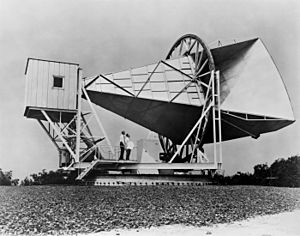Cosmic microwave background radiation facts for kids
The cosmic microwave background (CMB) is a faint glow of microwave radiation that fills the entire observable universe. Think of it as an "echo" or a "baby picture" of the universe when it was very young. Scientists believe it comes from the very first moments after the Big Bang.
If you look into space with a regular telescope, the areas between stars and galaxies seem completely dark. But a super sensitive radio telescope can pick up this faint glow. It's almost perfectly even everywhere you look. This means it's not coming from any specific star or galaxy.
The existence of the CMB is super important! It's one of the strongest pieces of evidence that the Big Bang theory is true.
Here's how it happened:
- Right after the Big Bang, the universe was incredibly hot and full of high-energy radiation (like very bright light).
- As the universe expanded, it also cooled down a lot.
- Because of this cooling and stretching, the high-energy light particles (called photons) lost most of their energy.
- Now, that ancient light has stretched out so much that it's in the microwave part of the electromagnetic spectrum. Microwaves have much lower energy than visible light.
- This radiation has been traveling freely through space ever since the universe became clear, about 380,000 years after the Big Bang. Before that, the universe was too hot and dense for light to travel far.
In 2013, a European team using the Planck cosmology probe released a detailed map of the CMB. This map helped scientists figure out that the universe is slightly older than they first thought. According to the Planck data, the universe is about 13.799±0.021 billion years old. That's a really long time!
How the CMB Was Discovered
The idea of the cosmic microwave background was first suggested in 1948 by scientists Ralph Alpher and Robert Herman.
The Accidental Discovery

In 1964, two scientists named Arno Penzias and Robert Woodrow Wilson were working at Bell Labs in New Jersey. They were using a special antenna, called a Dicke radiometer, to study radio signals from space and for satellite communication.
They kept finding a strange, steady "hissing" noise in their antenna. No matter where they pointed it, the noise was there. They tried everything to get rid of it! They cleaned pigeon droppings out of the antenna, thinking it was interference. But the noise wouldn't go away.
Meanwhile, at Princeton University, another group of scientists, including David Todd Wilkinson and Robert Dicke, were building their own equipment to *look* for this background radiation, which they believed should exist.
Penzias and Wilson eventually talked to the Princeton team. They quickly realized that the "noise" Penzias and Wilson were hearing was exactly what the Princeton scientists were looking for: the cosmic microwave background!
For their accidental but amazing discovery, Penzias and Wilson won the Nobel Prize in Physics in 1978.
Images for kids
See also
 In Spanish: Radiación de fondo de microondas para niños
In Spanish: Radiación de fondo de microondas para niños




